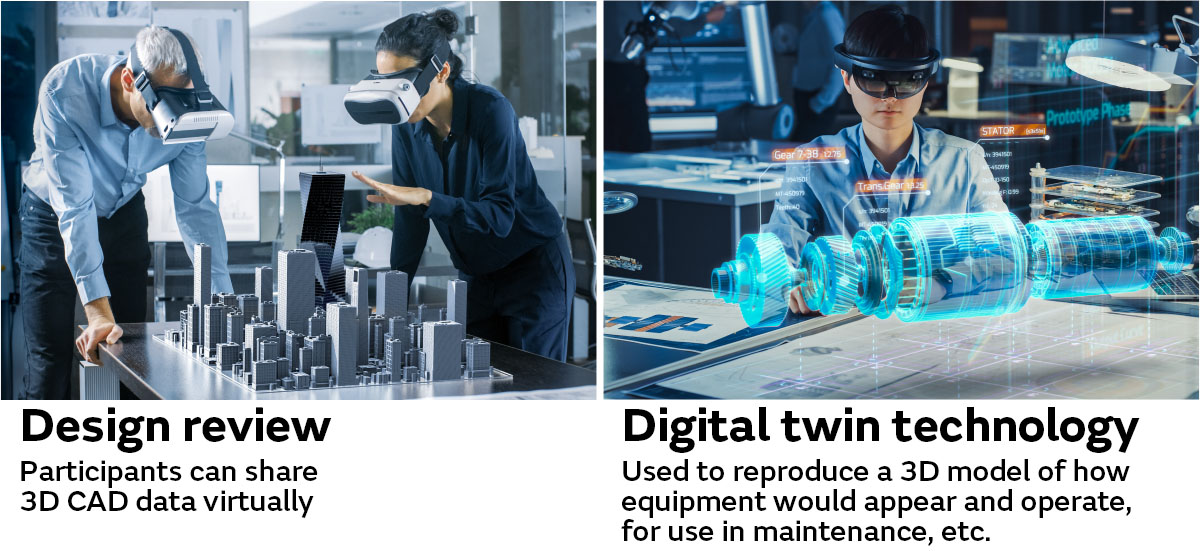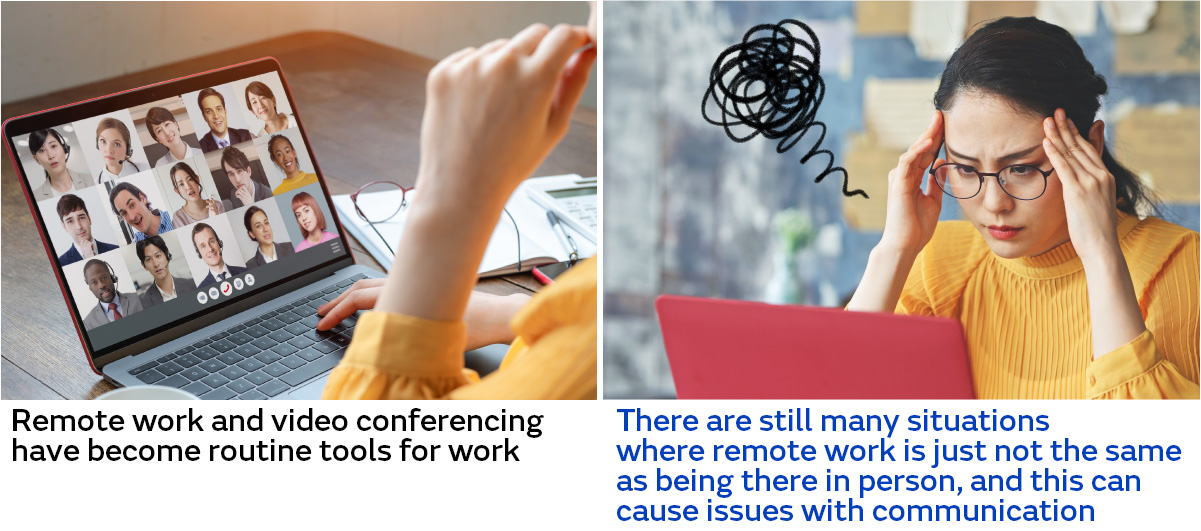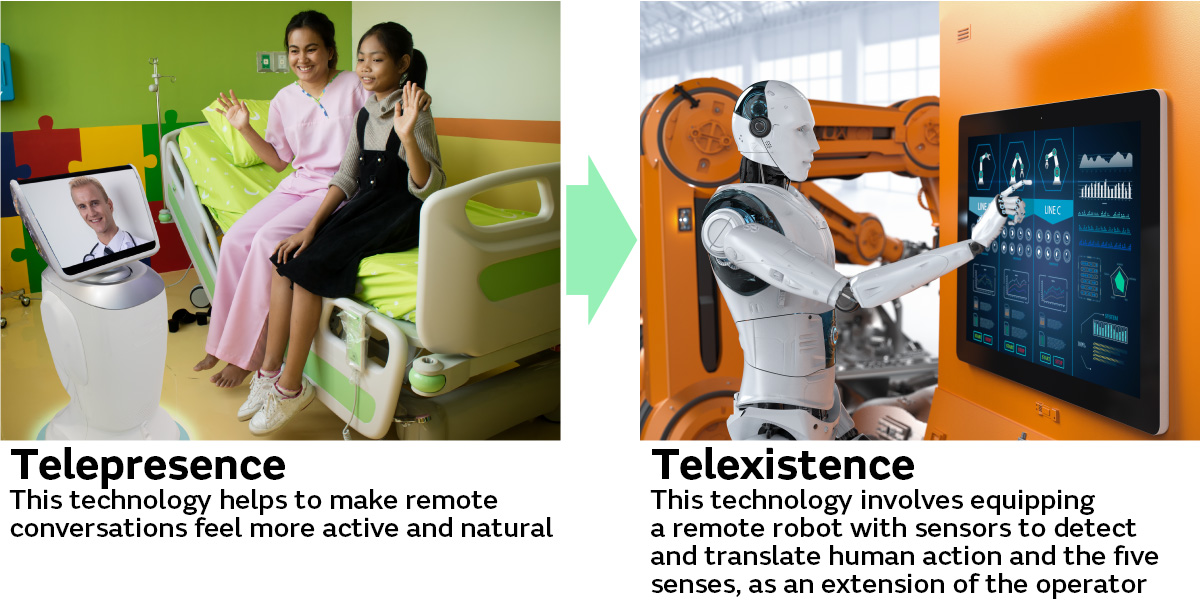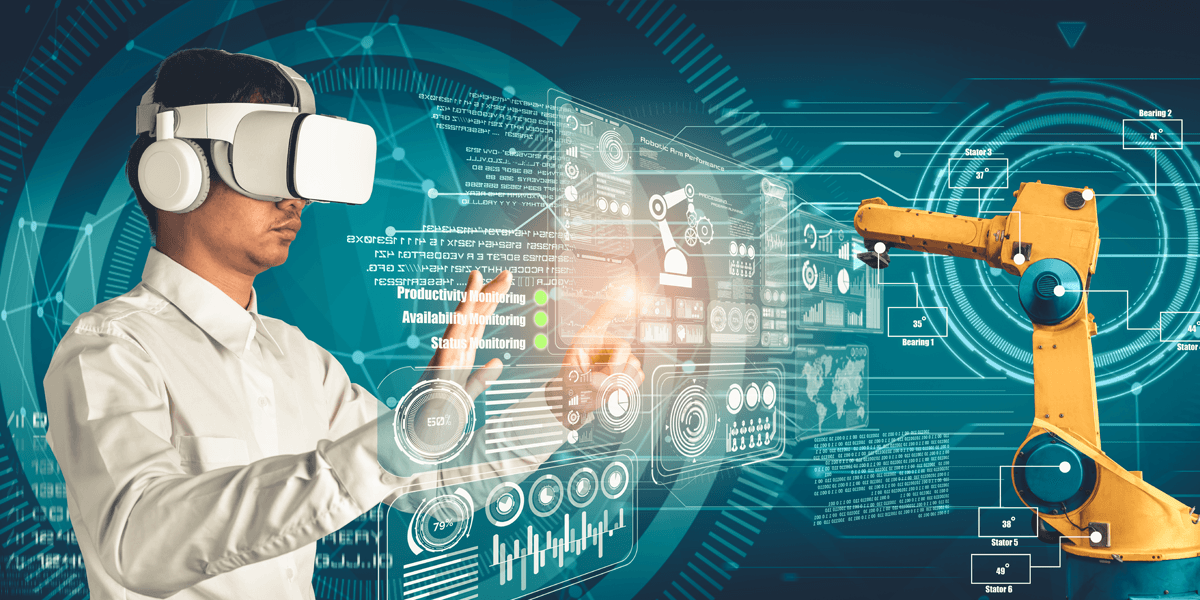Bringing humans and machines even closer with sensors and AI
Expanding the scope of remote work using VR/AR and 5G technologies
The spread of COVID-19 has changed how we live and work. With no choice but to restrict movement and reduce how often we meet others, we have moved many of our activities from the physical world to a virtual one. For many people, it seems only natural now to use remote technology to meet with friends, take classes, and have meetings.
Although remote work has become more commonplace, there are still many jobs that must be done in person
This use of virtual environments will likely continue even after the COVID-19 pandemic is over. This is especially true in business. There are several reasons why.
First, many people who thought online meetings would never work have realized that they in fact do work—and can even be more productive than face-to-face meetings. Having meetings online can reduce the amount of business trips taken and can also reduce cost and time. This means that even more meetings can be held for more people. Second, people disinclined to make use of ICT have been forced to make use of remote technologies, and this has helped to provide them with relevant skills. Working with remote technology has helped to eliminate disparity in ICT literacy and skills. Finally, the Japanese government continues to promote diverse working environments, and remote work is a great way to realize this goal. Remote work will also help support society and the people working within it as it becomes more established.
Some companies that have observed these trends have begun to revise their HR systems and reduce the sizes of their offices, under the assumption that remote work already plays a central role in business.
Although many tasks such as office work and preparing documents and materials can be performed remotely without issue, there are still many tasks that must be done on-site. Remote work is simply not an option in these cases. This is especially true at manufacturing sites.
Making full use of 3D CAD modeling to streamline VR/AR design work and maintenance
Manufacturing companies have begun making use of technologies such as virtual reality (VR), augmented reality (AR), and IoT as new means of communicating information in situations that previously could not work remotely, such as equipment maintenance and product design.
It has become possible in recent years to design all sorts of industrial products, equipment, and facilities using 3D CAD. This technology has been making tremendous progress. The individual parts of devices are now individually designed as 3D models, which can be assembled and even manipulated on a computer. This means that products can now be manufactured and tested, with no need to build a physical prototype.
When developing an industrial product (such as an automobile or electronic device) or designing a building or other structure, personnel such as product planners, salespeople, designers, and production engineers will meet to review the product. Until recently, this involved gathering all these individuals in the same room to discuss a physical prototype created especially for this purpose. Now, experts in remote locations can share 3D model data and then use head-mounted displays to manipulate and disassemble these models, allowing them to review a product just as though they were in the same room with it—or, perhaps in even more detail.

When designing manufacturing equipment or a machine tool, 3D data can be placed within a virtual production line that has also been modeled, allowing designers to verify that everything works together and operates safely—before even setting it up on-site.
These 3D models can also be used after the equipment has been actually installed on-site, in order to streamline work. AR can be used when maintaining equipment or facilities at a site to display technical information from the 3D model overlaid over the actual equipment, allowing for complicated tasks to be performed without error.
Sensors could also be installed on actual equipment. Data from these sensors could be imported to a 3D model on a server for use by the maintenance department or manufacturer, in order to create a digital copy that looks and operates exactly like the actual equipment on site. This so-called "digital twin" technology can be used to predict equipment failures or even simulate the impact of changing production conditions on factors such as throughput and durability.
However, using technologies such as VR, AR, and IoT requires a low-latency network capable of transmitting a large amount of data quickly between work sites and offices, as well as homes for remote work. 5G, a fifth-generation mobile communication system, is expected to play a major role in making this possible.
Using robots to provide a sense of presence to remote communication
As remote work becomes mainstream, it is becoming clear that this technology offers many unique benefits for office work. However, that doesn't mean that it provides the same level of communication as meeting face-to-face. Remote work technology is still in its infancy.
For example, many people might feel that something is slightly off when participating in a remote meeting, brainstorming session, or product review. You might think that using a videoconferencing system would allow you to easily see how everyone reacts to a statement, since you can see everyone on the screen. In reality, participants can often have trouble seeing how people react and are often not confident that their message is getting across. Online meetings have shown us that we rely on more than mere words and expressions to communicate.

This feeling that something is somehow off during remote meetings is a shared sentiment among people all over the world. In order to resolve current issues with using remote communication tools, companies and other organizations have begun implementing advanced communication technologies utilizing ICT that is still in the development stages. We are also seeing some attempts to use the latest in ICT and robotic technology to bring a sense of presence to remote meetings and customer service situations.
In the US, simple robots called telepresence robots are already being used by large companies, hospitals, schools, and other organizations as a means of communication. Telepresence robots are very simple looking robots consisting of a tablet installed on a mobile vehicle. The tablet is used to display of the face of the person speaking through the robot. The speaker can operate and move the robot remotely, allowing them to change the robot's facing while communicating with others in video chat.

It seems too simple to work, but you might be surprised. These robots can provide a greater sense of presence than simply using a tablet for video chatting.
The individual operating the robot can control it remotely, such as moving it around or changing its facing. When a tablet alone is used for communication, it is the other person who determines what you see. With a telepresence robot, the opposite is true. When speaking with multiple people, the operator of the robot can move the robot to face whomever they want to speak with. This could be of use in a variety of situations to make communication more active, such as moving around an exhibition to visit certain booths or seeking out certain individuals at a party or similar situation.
It can also be helpful for others to see such a robot moving around, which can provide a greater sense of the operator of the robot actually being there. All in all, this technology makes it possible for others to not only see your face and hear your voice, but to watch your robot react and move—and therefore more easily determine whether you are really paying attention!
Remote robots as a means to go anywhere, instantly
The technology of telexistence brings telepresence to the next level. This technology promises to provide an even higher level of communication, in which an individual remotely controls a robot called an avatar that reproduces the operator's movements and five senses. It is a concept advocated by Susumu Tachi, Professor Emeritus of the University of Tokyo.
With telepresence, the operator uses a controller or other device to consciously move a robot. With telexistence, however, sensors are used to detect the operator's movements and remotely control the robot without any conscious action on the part of the operator. Installing a camera on the robot to feed video to a head-mounted display (HMD) worn by the operator could therefore bring more immersion to remote communication and work. Haptic technology (discussed as the first topic of this series) could also be used to provide the operator with a sense of touch mirroring that of the robot for an even greater presence and sense of immersion.
In addition to workplaces, telepresence technology could be used for virtual tourism and even in healthcare facilities. Imagine a world where avatar robots are as common as shared bicycle stands. You could take control of such a robot through the Internet and be transported instantly to a tourist spot or other remote location.
Remote technology continues to transform rapidly as remote living and work become predominant
Remote technologies have traditionally served as secondary options for life and work, used only when traveling to a physical location or meeting face-to-face is not possible. This was true even at the start of the COVID-19 pandemic. However, we may soon see a world where remote work becomes predominant, with face-to-face meetings conducted only when absolutely necessary.
The remote technologies described here will continue to advance as this comes closer to reality. It seems likely that we will ultimately take the use of such technologies for granted, as we develop means of communicating and working that would not be possible except in remote environments. We will increasingly enter a future in which robots are used to communicate closely with others—and to experience many things previously not possible.
- Continue reading:Technology to quantify an individual's mental state

